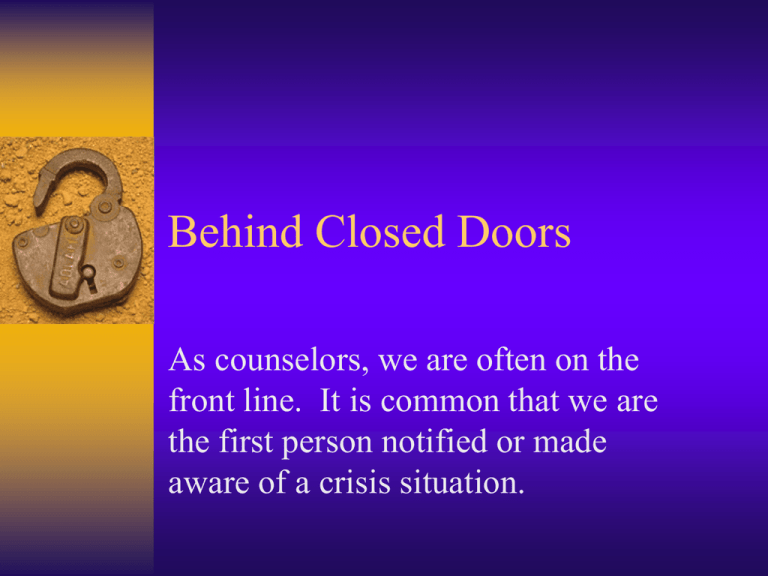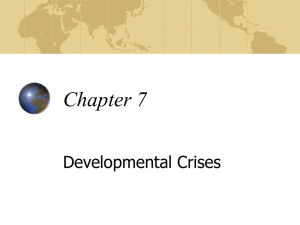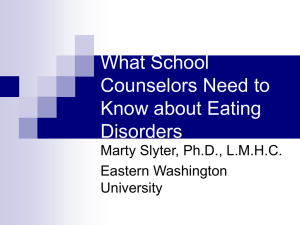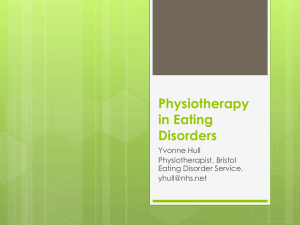
Behind Closed Doors
As counselors, we are often on the
front line. It is common that we are
the first person notified or made
aware of a crisis situation.
Introduction
It is often the counselor’s responsibility to:
– Intervene
– Ensure safety
– Provide counseling to those in crisis
– Referrals to agencies
Introduction
Purpose
– Present real life situations that occur in all
schools
– Give you insight into the many different types
of crisis situations that you may face
– Listen to your comments, opinions, and insights
as we present
Introduction
We will present the child involved, the crisis
situation, and course of action:
Jennifer---Physical Abuse
Dana--Sexual Abuse
Marci--Teen Pregnancy
Candace--Stereotypes, Gangs, & Eating
Disorders
Issue #1--Sexual Abuse
State of Indiana: Children with Sexual Abuse
November 2003 October 2003
November 2002
320
342
466
Marion County: Children with Sexual Abuse
December 2003 November 2003 December 2002
70
90
28
Sexual Abuse
Statistics
– 60 million survivors of childhood sex abuse
– 31% if women in state prison were abused
– 95% of teen prostitutes were abused
– Long term effects: fear, anxiety, depression,
anger, hostility, inappropriate sex behavior,
poor self-esteem, substance abuse, difficulty in
relationships
Sexual Abuse
Legal Distinctions
A. Child Sexual Abuse
B. Statutory Rape
C. Rape
Sexual Abuse
I. Childe Sexual Abuse
– States Abuse Laws Vary
– Major element: Perpetrator defined as a caretaker
II. Statutory Rape
– Laws are much more diverse & complex
– Learn the legal terms for each state
– Age usually ranges from 14-16 years (IN-16)
– Based on age differences too (ex: 16 yr.old can have
sex with 17 yr.old but not 23 yr.old
III. Rape
– Definition: Unlawful sexual activity with a person
without consent usually by threat or force
Sexual Abuse
Indiana’s Law (handout)
Sexual Abuse
I. Physical Cues that indicate Sexual Abuse
– Signs of difficulty in walking or sitting
– Torn, stained, or bloody clothing
– Indications of internal injury or bleeding
– Complaints of pain or itching in genital area
– Venereal disease in children under 13
– Pregnancy during or before adolescence
II. Most cases of sexual abuse leave no sign
Sexual Abuse
I. Behavioral Cues of Sexual Abuse
– Having poor peer relationships
– Appearing withdrawn, engaging in fantasy behavior
– Engaging in delinquent acts
– Displaying of bizarre, sophisticated, or unusual sexual
knowledge or behavior
– Verbal disclosure
– Self mutilation
– Engaging in sexual activities with another child
Sexual Abuse
I. Do children lie about being molested?
– Not usually
Sexual Abuse
I. Why do many children NOT tell when
they are abused?
–
–
–
–
–
–
Fear
Unaware of the nature of the abuse
Lack of trust
“At fault” feeling
Protection of perpetrators
Secrecy
Sexual Abuse
Behind Closed Doors
– Case Study Handout
Sexual Abuse
Plan of Action
– 1. Did proper authorities get notified?
– 2. What was done to ensure the safety of the
child?
– 3. What outside organizations were contacted
for additional help for the child?
– 4. What support plant was put in place for the
child?
– 5. What could have been to prevent this?
Sexual Abuse
What authorities need to be notified?
– Child protective services
– School Principal or school district designee
– Maybe even law enforcement
What else needs to be done to ensure safety
– School should NOT investigate
– If school is afraid to send kid home, call CPS
– CPS or Law should contact parent
– CPS or Law initiates investigation
– CPS will send feedback report after 30 days
Sexual Abuse
What outside organizations should be
contacted?
– Social Workers
– Legal Representatives
– Outside Therapists
• Know local therapists & agencies
What support plans need to be put in place?
– Regular meetings with school counselor
– Counselor should serve as coordinator
Sexual Abuse
Counselors Duty
Legal Issues
– Reporting: Should report sexual abuse
– Questions: Call CPS & present hypothetical
situation
Ethical Issues
– Clear & Imminent Danger
• Statutory Rape
• Rape
Sexual Abuse
Prevention Activities
– Conduct in service training for school
personnel
– Develop a consultation of network counselors
– Know CPS workers, therapists, etc.
– Develop a system for maintaining accurate
professional school counseling records
– Establish an abuse prevention program at
school
Issue # 2--Physical Abuse
Definition of Physical Abuse
– Indiana State Definition
– Harm Standard
– Endangerment
Physical Abuse
Statistics
– Indiana (2003) 61,492 children reported
– 51 Fatalities in the last 5 years
– Perpetrators-age, race, relationship
Physical Abuse
Risk Factors
1. Family Problems
– Lower socioeconomic status
– Marital issues
– Domestic violence
2. Parenting
– Single parents
– Inexperienced or isolated parents
– Heavy child care responsibilities
3. Other Factors
– Emotionally disturbed
– Alcohol or drug problems
Physical Abuse
What to Look for
– Unexplained damage to the body
– Evidence of an accumulation of injuries over
time
– Patterned injuries
– Damage in unlikely places
– Excessive damage to eyes or mouth
Physical Abuse
Signs from the child
– Changes in behavior
– Learning problems
– Over complaint, always watchful, withdrawn
Physical Abuse
Signs from the adult or caregiver
– Discipline
– History of abuse
– Unconvincing explanations
Physical Abuse
Impact of Physical Abuse
– Physical
– Social
– Emotional
– Adult impact
Physical Abuse
Interventions for Parents
– Anger management goals
– Educating useful skills
– Appropriate social services marital counseling,
psychotherapy
Physical Abuse
Interventions for Child
– Anxiety management techniques
– Play therapy
– Social skills training
Physical Abuse
Prevention
– Early Detection and knowledge
– Tranferrance
– Focus on general population and subgroups
•
•
•
•
Media campaigns
Peer helplines
Social support
In-home service
Physical Abuse
Case Study
– Kellie
– First grader
– Three incidences
– CPS involvement
Issue #3--Teen Pregnancy
Teen Pregnancy remains a major problem
The U.S. still has highest rates among
industrialized countries
Fact: 10, 974 teens gave birth in Indiana in
2003
Fact: All high school counselors will have
to assist pregnant teens every school year
Teen Pregnancy
Statistics
– 4 in 10 girls become pregnant by age 20
– > 900,000 teen pregnancies annually
– 40% of pregnant teens are 17 or younger
– 8 in 10 teen pregnancies are not planned
– 79% of pregnant teens are not married
– Some teens are having sex earlier
– Hispanics now have the highest teen birth rate
Teen Pregnancy
Why should we care?
– 4 in 10 teen mothers graduate
– Half of teen mothers drop out of school before
becoming pregnant
– 52% of all mothers on welfare had a child as a
teen
– Teen pregnancy costs taxpayers $7 million/yr
– Teen mothers have babies with higher rates of
defects
Teen Pregnancy
Helpful Information
– Few school officials take a stand against teen
pregnancy
– Arguments over abstinence vs. birth control use
up resources
– Programs have a high rate of effectiveness
– Peer pressure effects teen behavior
– Prevention is geared towards girls, not boys
Teen Pregnancy
Signs that someone is At-Risk at school
– Low grade average
– Poor self-esteem
– Provocative clothing
– Long term relationship
Teen Pregnancy
What should we do?
– Increase your commitment to prevent teen
pregnancy (become an activist)
– Maintain good relationships with kids
– Provide programs to students
– Create a newsletter to parents to increase their
awareness
– Group therapy sessions on the pressure to have
sex as teens
Teen Pregnancy
Helpful Website
www.cfoc.org
– Lesson Plans
– How to start a Prevention Program
– Forum
Teen Pregnancy
Take a role in stopping the cycle!
Daughters of teen parents are 22% more
likely to have a baby as a teen
13% of sons of teen parents end up in prison
Children of teen mothers do worse in school
Too many teens still believe “it won’t
happen to me”
Teen Pregnancy
Teachers and counselors are often the first
people told by the student
How will you handle the situation?
What can you do to help?
What issues will we face? (abortion,
miscarriages, raising the baby)
– 1/3 of teen pregnancies will end in abortion, 1/3
will miscarry, 1/3 will keep baby
Teen Pregnancy
Video clip: “Teen Pregnancy in America”
Brochures
www.teenpregnancy.org
Teen Pregnancy
CASE STUDY
– Sharika is a 15 year old sophomore that
suspected she was pregnant. After discussing
her problem with a teacher she had a test done
at a local clinic. It was positive. She explained
that she just started having sex with her live-in
18 year old boyfriend. They used condoms a
few times. The principal contacted the mother
about the pregnancy. Currently, she is 8 months
along and plans on raising the baby.
Teen Pregnancy
Plan of Action
– 1. Did proper authorities get notified?
– 2. What was done to ensure the safety of the
child?
– 3. What outside organizations were contacted
for additional help for the child?
– 4. What support plant was put in place for the
child?
– 5. What could have been to prevent this?
Issue #4--Eating Disorders,
Stereotypes, & Gangs
Eating is controlled by many factors:
– Appetite
– Food availability
– Family, peer, and cultural practices
– Attempts at voluntary control
– www.abouteatingdisorders.org
Eating Disorders, Stereotypes, &
Gangs
Dieting to a dangerously low body weight is
highly profiled by:
– current fashion trends
– sales campaigns for foods
– Some professions
Eating Disorders, Stereotypes, &
Gangs
Facts
Diet industry claims an annual profit of $10
billion a year
Eating disorders involve serious
disturbances in eating behavior such as:
– Extreme reduction of food intake
– Severe overeating
– Feelings of concern about body weight & type
Eating Disorders, Stereotypes, &
Gangs
Eating disorders are real, treatable, medical
illnesses in which certain patterns of eating
take on a life of their own
Three types:
– Anorexia Nervosa--(our focus for the
presentation)
– Bulimia Nervosa
– Binge-eating--not a proven psychiatric disorder
Eating Disorders, Stereotypes, &
Gangs
Common Behaviors of Anorexia Nervosa
– Restricting amount & type of food
– Excessive and/or compulsive exercise
– Abuse of diuretics/laxatives
– Smoking
– Hiding food
– Vegetarianism/special diet
– Elaborate food preparation
– Avoidance of eating in public, mirrors
– Weighing: self, food
– Self mutilation
– Substance abuse
Eating Disorders, Stereotypes, &
Gangs
Anorexia Nervosa: Common Verbalizations
– Denial of behavior
– Denial behavior is a problem
– Need to lose weight
– Very knowledgeable about nutrition, diet
– Talk about food, menus, recipes
– Requests for reassurance re: thinness, size of body
parts, etc.
– Body as a collection of parts vs.. whole
– Self-denigration
Eating Disorders, Stereotypes, &
Gangs
Anorexia Nervosa: Common Beliefs
– Thin=good, lucky, beautiful, intelligent, in
control, etc.
– Fat=bad, unlucky, ugly, stupid, out of control
– Certain foods are “bad” or “dangerous”
– Being fat is the worst possible outcome
– Others bodies are “fine” but others are
untrustworthy when giving feedback
– Self as inadequate, unworthy or damaged
Eating Disorders, Stereotypes, &
Gangs
Anorexia Nervosa: Common Experiences
Depression
Anxiety, panic, and/or obsessions
Able to present good façade
History of substance abuse self/family
Shame
Early history of trauma, abuse
Live in fear of being found out
See their behaviors as helpful
Eating Disorders, Stereotypes, &
Gangs
Anorexia Nervosa: Common Physical Problems
Malnutrition
Dehydration
Electrolyte imbalances
Dry skin/hair
Halitosis
Fatigue/weakness
Cramps, bloating, diarrhea
Dental erosion
Hypo/hyperglycemia
Blood pressure problems
Eating Disorders, Stereotypes, &
Gangs
Anorexia is the 3rd most chronic illness in
adolescent women
Anorexia is estimate to occur in .5% to 3%
of all teenagers
Anorexia usually occurs in adolescence
Over the past 40 years, anorexia has been
steady in teenagers but has increased
threefold in young women
Eating Disorders, Stereotypes, &
Gangs
90% of eating disorder cases are in females,
but rate for males is increasing
In 2000 teens 13% of girls& 7% of boys
had an eating disorder
Men are more apt at concealing eating
disorders so the incidence may be
underreported
Men with eating disorders often struggle
with sexuality
Eating Disorders, Stereotypes, &
Gangs
Most studies on eating disorders have been
using white, middle class females
Studies now report all races are affected
There is evidence that show that African
American & Hispanics are at risk due to
cultural attitudes
Eating Disorders, Stereotypes, &
Gangs
Populations at risk:
Women athletes
Male athletes
Men & women in military
Vegetarians
Girls who undergo early puberty
Eating Disorders, Stereotypes, &
Gangs
What causes eating disorders?
– Not one single cause
– Concerns about weight or body shape
– Cultural/family pressures
– Emotional/personality disorders
– Genetics & biological factors
Eating Disorders, Stereotypes, &
Gangs
Avoidant personalities
Dependent personalities
Narcissistic personalities
**All have been linked with Anorexia
www.reutershealth.com/wellconnected/d
oc49.html
Eating Disorders, Stereotypes, &
Gangs
Accompanying emotional disorders
– Obsessive compulsive disorder
– Phobias
– Panic disorder
– Post-traumatic stress
– Depression
– Body dysmorphic disorder
– Muscle dysmorphia
Eating Disorders, Stereotypes, &
Gangs
Other contributing factors:
– Negative family influence
– Genetic Factors
– Cultural pressures
Eating Disorders, Stereotypes, &
Gangs
Standard Criteria for Confirming Diagnosis
– Patient’s refusal to maintain a normal body
weight
– Intense fear of becoming fat
– Distorted self image
– Denial of emaciation & starvation
– Loss of menstrual cycle for 3 months
– Restricting/Severe Dieting
– Binge/Purge Behavior (anorexia bulimia)
Eating Disorders, Stereotypes, &
Gangs
Treatment:
At this time, no treatment program is completely
effective and 50% never achieve normal weight
General treatment:
–
–
–
–
–
–
Hospitalization
Nutritional therapy
Drug therapy
Interpersonal therapy
Family therapy
Treating medical problems
Eating Disorders, Stereotypes, &
Gangs
Video Clip: “Trouble in Mind:Eating
disorders”
Eating Disorders, Stereotypes, &
Gangs
Case Study
– Ray
Eating Disorders, Stereotypes, &
Gangs
Course of Action
– Counselor met with Ray. Talked about the issues that
his teachers have brought up. He denied the accusations
– The counselor made an agreement with Ray. If he
didn’t want to eat school lunch, he had to bring his
own. He could keep in teacher lounge refrigerator. If
Ray didn’t comply, the counselor would involve people
out of school
– Ray didn’t bring lunch for 2 days. On the 3rd day he
ate some pizza during lunch & went to rest room to
throw it up. His teachers reported it to counselor
Eating Disorders, Stereotypes, &
Gangs
The counselor determined he either made
himself get sick or he got sick because he
hadn’t been eating on regular basis
Counselor called his mom & told her about
the behaviors. Ray’s mom said she would
take him to the doctor
Eating Disorders, Stereotypes, &
Gangs
Ray’s mom still hasn’t taken Ray to Dr.
Ray is angry with teachers & counselor for calling
his mom & still denies problem
Ray has been eating at school, maybe to keep
everyone off his back
Ray meets with counselor every week and his
teachers give counselor feedback
If the counselor feels Ray’s health is in danger, the
parent will be contacted again and urged to take
Ray to the Dr.
Eating Disorders, Stereotypes, &
Gangs
If the parent does not comply, the counselor
will need to report this scenario to the
school police and file a CHINS report
Police will then take Ray to Wishard
Hospital where he will be evaluated










